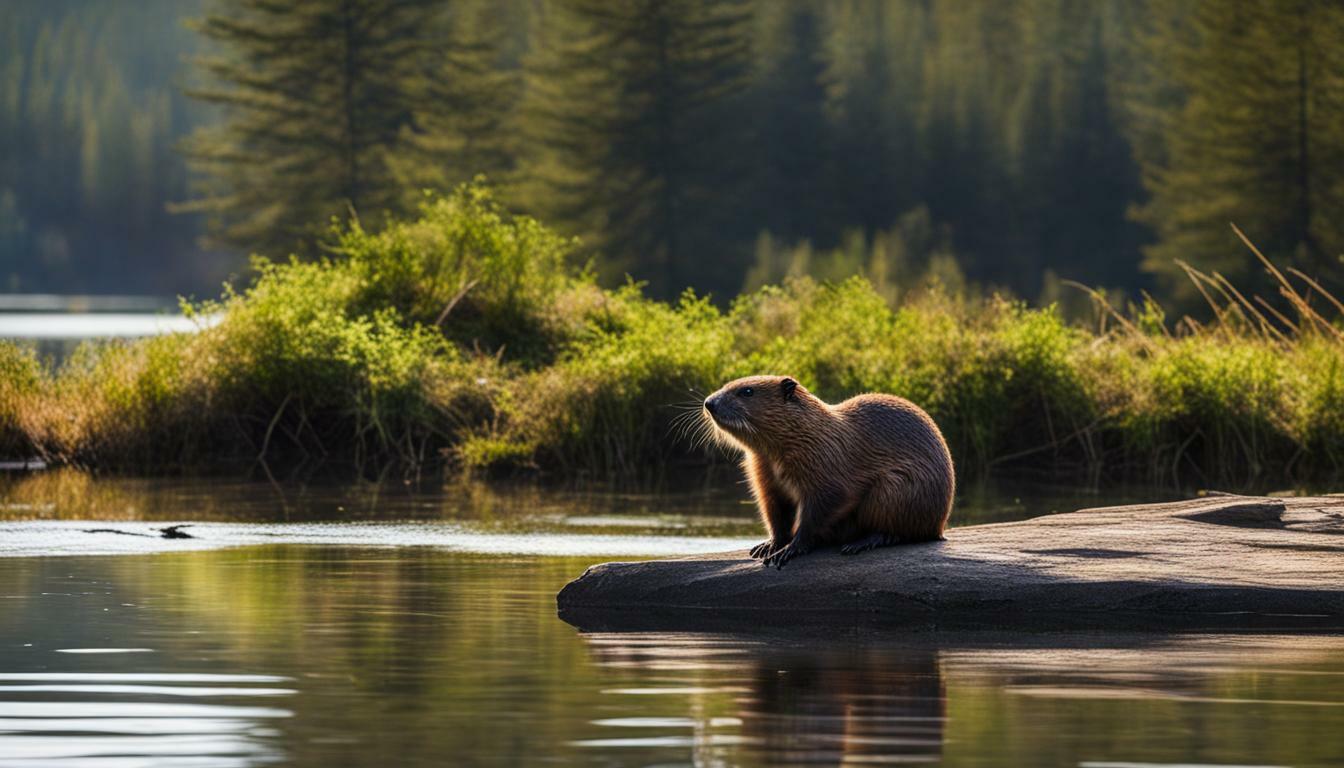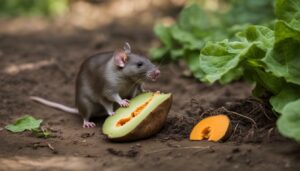Have you ever wondered what sounds beavers make and what they mean? These fascinating creatures have a unique way of communicating with each other through vocalizations. In this article, we will explore the various sounds they make and the significance behind each one. From moans and mumblings to potential low-pitched moans, we’ll delve into the world of beaver vocalizations and their role in communication.
Key Takeaways:
- Beavers make a variety of sounds, including moans and mumblings.
- These sounds are particularly prominent during the autumn season.
- Young beavers are believed to emit moans to express contentment while chewing on small limbs.
- It is possible that adult beavers also make low-pitched moans, but this is not certain.
- Scientists have captured beaver vocalizations through audio recordings, providing a means to study their communication.
Understanding Beaver Communication
Communication plays a vital role in the beaver community, and understanding their vocal behaviors is key to unraveling their social dynamics. Beavers have a unique way of conveying messages through vocalizations, allowing them to communicate various needs and intentions to their fellow colony members.
One of the most distinctive sounds produced by beavers is the moans and mumblings that can be heard echoing from within their dens, particularly during the autumn season. These vocalizations are believed to be predominantly made by young beavers, expressing their contentment as they chew on small limbs. The rhythmic nature of these moans suggests a sense of satisfaction and harmony within the colony.
While the moans of young beavers are well-documented, the vocalizations of adult beavers remain somewhat mysterious. It is possible that adult beavers also emit low-pitched moans, but further research is required to confirm this behavior. Scientists have captured these intriguing beaver sounds through advanced audio recordings, offering glimpses into the vocal repertoire of these fascinating creatures.
The Significance of Beaver Communication
Effective communication within a beaver colony is crucial for their social interactions, mating rituals, and overall survival as a species. By decoding and understanding their vocalizations, researchers are able to gain insights into the complex relationships and hierarchical structures that exist within beaver communities.
Through their vocal behaviors, beavers are able to convey information about resources, establish territorial boundaries, and signal warnings of potential threats. By studying the meanings behind specific sounds, scientists can piece together a more comprehensive understanding of beaver communication and its role in shaping their behavior and ecological impact.
| Benefits of Understanding Beaver Communication | Implications for Research |
|---|---|
| Enhanced understanding of social dynamics within beaver colonies | Development of conservation strategies to protect beaver habitats |
| Insights into mating rituals and reproductive behaviors | Identification of potential vocalizations related to specific environmental conditions |
| Improved management of beaver-human conflicts | Further exploration of the role of vocalizations in beaver survival and adaptation |
As we continue to unravel the mysteries of beaver communication, we gain a deeper appreciation for the intricate social structures and behaviors of these remarkable creatures. By listening to their moans and deciphering their vocal repertoire, we come one step closer to understanding the fascinating world of beavers.
The Moans and Mumblings of Beavers
Moans and mumblings are intriguing vocalizations that beavers use to communicate with each other. These unique sounds can be heard from within their dens, especially during the autumn season. Beavers are known for their impressive vocal repertoire, which includes a variety of calls, but it is the moans and mumblings that stand out as prominent vocal behaviors.
One fascinating aspect of beaver vocalizations is the role that moans play in expressing contentment. It is believed that young beavers emit moans while chewing on small limbs, indicating their satisfaction. This vocal behavior showcases the emotional state of these young beavers and adds to our understanding of their social interactions.
While moans are commonly associated with young beavers, there is also speculation about adult beavers producing low-pitched moans. However, the exact reasons behind adult beaver moans remain mysterious and need further research to be deciphered. By capturing beaver vocalizations through audio recordings, scientists have been able to study the range of vocal behaviors exhibited by these fascinating creatures.
The Beaver Vocal Repertoire
| Vocalization Type | Description |
|---|---|
| Moans and Mumblings | Low-pitched vocalizations believed to express contentment, especially among young beavers. |
| Other Calls | Beavers also produce a range of other calls, including grunts, whines, and growls, to communicate different messages and express various emotions. |
Through these sound recordings, researchers have been able to identify and categorize different types of beaver vocalizations, contributing to our understanding of their communication and social dynamics. These vocalizations play a vital role in beaver communities, helping them coordinate their activities and navigate their complex habitats.
Understanding the significance of beaver vocalizations not only highlights the unique behaviors of these fascinating creatures but also emphasizes the importance of conservation efforts. By protecting beaver habitats, we ensure the preservation of their intricate communication systems and contribute to the overall health and balance of our ecosystems.
Contentment Expressed Through Moans
Moans serve as an indicator of contentment for young beavers as they engage in their chewing activities. These vocalizations, characterized by low-pitched sounds, can often be heard emanating from within their dens, especially during the autumn season. As young beavers chew on small limbs, the moans they emit signify their satisfaction and sense of well-being.
The significance of these moans lies in the expression of contentment. It is believed that the rhythmic chewing motion, combined with the emitted sounds, creates a soothing effect for the young beavers. These vocalizations provide a form of communication among the young members of the beaver community, reinforcing their sense of belonging and promoting social interactions.
While the purpose of these moans is well understood in young beavers, the vocalizations of adult beavers remain a mystery. Although there is a possibility that adult beavers also produce low-pitched moans, further research is needed to confirm this hypothesis. The study of beaver vocal behaviors is an ongoing field of research, with scientists using sound recordings to gain insights into the communication habits of these fascinating creatures.
| Young Beavers | Adult Beavers |
|---|---|
| Moans indicate contentment during chewing activities | The vocalizations of adult beavers are still under investigation |
| Moans serve as a form of social communication | More research is needed to understand adult beaver vocal behavior |
| Moans reinforce a sense of belonging among young beavers | The role of vocalizations in adult beaver interactions is yet to be fully understood |
Recordings of beaver vocalizations have provided valuable insights into their communication repertoire. By analyzing these audio recordings, researchers can identify different types of vocalizations and examine their meanings within the context of beaver behavior. This scientific advancement allows us to delve deeper into the fascinating world of beaver communication and gain a better understanding of their social dynamics.
As our knowledge of beaver vocalizations continues to expand, so does our appreciation for these remarkable creatures. The study of their communication habits contributes to our understanding of their unique behavior and ecological impact. By unraveling the mysteries behind their vocalizations, we enhance our ability to conserve and protect their habitats for future generations to come.
The Mystery of Adult Moans
The moans produced by adult beavers remain a fascinating area of study, as researchers try to uncover their purpose and significance. While it is not certain whether adult beavers make low-pitched moans like their younger counterparts, there are intriguing possibilities to explore.
Some experts speculate that adult beaver moans could serve as a form of communication, possibly indicating a range of emotions or intentions. These vocalizations may play a role in establishing territory boundaries, expressing aggression or submission, or even attracting potential mates.
Researchers are using advanced audio recording technology to capture the elusive sounds of adult beavers. By analyzing these recordings, scientists hope to decode the meaning behind the moans and gain a deeper understanding of how beavers communicate within their communities.
| Possible Significance of Adult Beaver Moans | Potential Findings |
|---|---|
| Establishing territory boundaries | Insights into beaver social dynamics and territorial behavior |
| Expressing aggression or submission | Understanding the hierarchy within beaver colonies |
| Attracting potential mates | Revealing the role of vocalizations in beaver courtship rituals |
While the mysteries surrounding adult beaver moans continue, the ongoing research provides a glimpse into the complex world of beaver vocalizations. These intriguing sounds add to the richness of their communication system and highlight the importance of understanding their behaviors for conservation efforts and ecological studies.
Recording Beaver Sounds
Thanks to advancements in technology, researchers can now capture and analyze the intricate sounds produced by beavers. These audio recordings offer invaluable insights into their communication and behavior patterns. By studying the vocalizations of beavers, scientists have been able to unravel the mysteries of their social interactions and ecological impact.
Using specialized equipment, such as hydrophones and sensitive microphones, researchers have been able to capture a wide range of beaver vocalizations. These recordings have revealed the diversity of sounds that beavers produce, including the distinct moans and mumblings that are particularly prominent during the autumn season.
By analyzing the frequencies and patterns of these vocalizations, researchers have decoded how beavers use sounds to convey messages within their habitats. It is believed that young beavers emit moans to express contentment while chewing on small limbs, indicating their satisfaction. However, the mystery behind low-pitched moans produced by adult beavers still remains unsolved.
The availability of beaver audio recordings has revolutionized our understanding of these fascinating creatures. Through careful analysis and interpretation, researchers continue to deepen our knowledge of beaver vocalizations and their role in communication, social dynamics, and overall survival as a species.
Table: Notable Beaver Vocalizations
| Vocalization | Description |
|---|---|
| Moans and Mumblings | Distinct sounds produced by beavers, especially during autumn, which may indicate contentment or other messages. |
| Low-pitched Moans | Possibly emitted by adult beavers, but the exact meaning and purpose of these vocalizations are still uncertain. |
By delving into the world of beaver vocalizations and the technology behind recording them, scientists are gaining a deeper understanding of these incredible creatures. Through ongoing research and analysis, we continue to uncover the captivating intricacies of beaver communication.
Decoding Beaver Vocalizations
By decoding their vocalizations, scientists have gained valuable insights into the intricate language of beavers. These fascinating creatures use a variety of sounds to communicate with each other, and understanding their vocal behaviors is crucial to comprehending their social interactions and ecological impact.
One of the most prominent vocalizations of beavers is the moans and mumblings, which are often heard coming from their dens, particularly during the autumn season. These sounds are believed to be made by young beavers, expressing their contentment as they chew on small limbs. It is a remarkable way for these young individuals to communicate their satisfaction and well-being to the rest of the beaver community.
While moans and mumblings are predominantly associated with young beavers, there is also a possibility that adult beavers emit low-pitched moans. However, research has not provided conclusive evidence regarding this aspect of adult beaver vocalizations. Further investigation is necessary to unravel the mystery behind these potential vocalizations and their significance within the beaver community.
Through the use of advanced audio recording technology, scientists have captured the vocalizations of beavers, allowing for detailed analysis and interpretation. These recordings have revealed the complex vocal repertoire of beavers and shed light on the various sounds they use to communicate with each other. Researchers can now distinguish between different types of vocalizations and decipher the meanings behind specific sounds, contributing to a better understanding of beaver communication and behavior.
| Type of Vocalization | Description |
|---|---|
| Moans and Mumblings | Low-pitched sounds emitted by young beavers to express contentment. |
| Possible Adult Moans | Low-pitched sounds of uncertain origin, potentially made by adult beavers. |
| Other Vocalizations | Additional sounds used by beavers for communication purposes, yet to be fully documented and understood. |
In conclusion, beaver vocalizations play a crucial role in their social interactions and overall survival as a species. By decoding their vocal language, scientists have been able to gain valuable insights into the complex communication system employed by these remarkable creatures. Further research is needed to fully comprehend the significance of different vocalizations and their intricate meanings within the beaver community.
The Significance of Beaver Communication
Communication is an essential aspect of beaver life, serving various purposes in their social structure and survival strategies. Through their vocalizations, beavers establish and maintain connections within their community, sharing important information and coordinating their activities. These unique sounds play a crucial role in their daily lives as they navigate their complex aquatic habitats.
One significant aspect of beaver communication is the expression of contentment through moans. Young beavers are known to emit these low-pitched sounds while chewing on small limbs, indicating their satisfaction and well-being. It is fascinating to observe how these moans serve as a form of social bonding among the younger members of the beaver population.
While the moans of young beavers are well-documented, the vocalizations of adult beavers remain somewhat of a mystery. There is a possibility that adult beavers also produce low-pitched moans, but further research is needed to fully understand their purpose and significance. These intriguing vocalizations may be a form of communication related to territoriality, mating rituals, or other important aspects of adult beaver life.
| Vocalization Type | Significance |
|---|---|
| Moans and mumblings | Expression of contentment among young beavers |
| Potential adult moans | Unknown purpose, potentially related to territoriality or mating |
Scientific advancements have allowed researchers to capture and study beaver vocalizations through audio recordings. By analyzing these recordings, scientists can decode and interpret the different types of beaver vocalizations, expanding our understanding of their communication methods. These studies provide valuable insights into the social dynamics and behavioral patterns of beavers, ultimately contributing to broader ecological research.
Overall, the significance of beaver communication cannot be overstated. Through their vocalizations, beavers establish social bonds, convey important messages, and enhance their chances of survival as a species. By delving deeper into the fascinating world of beaver vocalizations, scientists and nature enthusiasts alike gain a greater appreciation for the intricate ways in which animals communicate and interact within their environments.
Conclusion
The vocalizations of beavers offer us a glimpse into their world and remind us of the rich complexity of nature’s communication systems. These fascinating creatures have a unique way of expressing themselves through various sounds, including moans and mumblings. These vocalizations can be heard from within their dens, especially during the autumn season.
One particular vocal behavior observed among young beavers is emitting moans while chewing on small limbs, which is believed to express contentment. While it is not certain, there is also a possibility that adult beavers produce low-pitched moans, adding to the mystery surrounding their vocal repertoire.
Thanks to advancements in technology, scientists have been able to capture these beaver vocalizations through audio recordings. This has provided an opportunity to study their communication methods and better understand the meanings behind specific sounds. By decoding these vocalizations, researchers can gain insights into beaver social interactions, mating rituals, and overall survival as a species.
Understanding beaver vocalizations is not only fascinating but also crucial for appreciating the unique behavior and ecological impact of these remarkable creatures. It reminds us of the intricate ways in which animals communicate and how vital communication is for their existence. So the next time you hear the sounds of beavers in the wild, take a moment to marvel at the complexity of their communication system and the wonders of nature.
FAQ
What sounds do beavers make?
Beavers make a variety of sounds, including moans and mumblings. These sounds can be heard from within their dens, especially during the autumn.
What are the moans believed to be made by?
The moans are believed to be made by young beavers, expressing their contentment as they chew on small limbs.
Do adult beavers also make moans?
It is possible that adult beavers also make low-pitched moans, but it is not certain.
How can I hear beaver sounds?
You can listen to sound recordings of beaver vocalizations to get a glimpse into their communication.
What is the significance of beaver communication?
Communication plays a vital role in the lives of beavers, contributing to their social interactions, mating rituals, and overall survival as a species.




